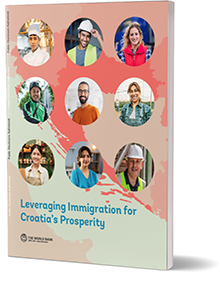Background and Findings
Croatia is at a critical demographic crossroads. The country has lost close to 400,000 residents over the last decade, positioning it among the top five nations in the European Union with a declining population. The proportion of elderly people—those aged 65 and older surged from 17.9% in 2012 to 22.5% in 2022, with forecasts indicating it could reach 30% by 2050. Croatia also faces significant labor shortages, with job openings consistently outnumbering available unemployed individuals since 2016. The demand for labor is expected to increase, with projections suggesting Croatia might need more than 300,000 workers by 2035.

Leveraging Immigration for Croatia’s Prosperity
Immigration has increasingly become a solution to address these workforce challenges. Foreign-born residents comprise 12.7% of the population, with a sharp increase in labor immigration in recent years. Annual first-time work permits for foreign citizens rose from under 10,000 before 2016 to close to 80,000 in 2023. Migrants provide important economic benefits by addressing critical labor shortages and bolstering the welfare system. They are primarily concentrated in high labor demand sectors such as construction, tourism, hospitality, and manufacturing. However, inadequate information among foreign workers leaves them vulnerable to exploitation and prevents them from reaching their full potential. Many arrive without suitable skills, while language barriers and cultural differences can impede their integration into Croatian society.
The report "Leveraging Immigration for Croatia's Prosperity", assesses Croatia’s migration system and proposes strategic policy actions to maximize immigration’s positive impacts while addressing key challenges for Croatia’s economy.
Recommendations
Policy recommendations include:
- Strengthening immigration governance: Croatia can develop a comprehensive migration strategy with action plans, timelines, and funding to attract, train, and integrate foreign workers effectively. The country can expand bilateral and multilateral labor and social security agreements and implement Global Skills Partnerships to meet Croatia's specific skills needs and address brain drain concerns.
- Enhancing regulations: Croatia needs to establish recruitment agencies’ licensing and monitoring to reduce migrants’ costs and enhance their legal protection. For employers, Croatia should invest in robust monitoring and enforcement mechanisms to ensure labor law compliance.
- Aligning selection process with labor market needs: Croatia can strengthen its labor market information system to include forecasts of skill and occupation demands. The selection process should be more transparent, trackable, and streamlined.
- Ensuring effective matching of skills and integration: Croatia can improve migrant recruitment by providing detailed job information in native languages and address skills shortages by recognizing foreign qualifications, through cooperation with origin countries on quality standards. Integration support can be expanded through services like orientation programs, language training, and labor market access. Establishing one-stop-shop service centers with multilingual and multi-channel assistance can offer effective help.
- Leveraging technology and data: Enhance data collection efforts and implement digital solutions can improve the overall migration system.
By embracing immigration as an important human resource strategy, Croatia can tackle labor shortages and stimulate sustainable economic development. The policy measures discussed in this report can help create a more effective, equitable, and resilient immigration system that benefits both native and foreign-born populations while supporting the country’s long-term development goals.
